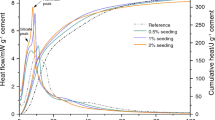Abstract
Volume changes can be calculated from the hydration stoichiometry of C3S if the composition of C-S-H is taken as C1.7SH4.0 with a density of 1.85 g/cm3. The results are in general agreement with the volume changes determined by Powers. However, the calculated evaporable water content is higher and the space-limiting water-cement ratio is calculated to be 0.42. The calculations can be applied also to the pozzolanic reaction and predict a marked increase in solid volume. In that case the composition of C-S-H is modified to C1.5SH3.8.
Similar content being viewed by others
References
T. C. Powers and T. L. Brownyard, J. Amer. Concr. Inst., 41, 101–132, 249–336, 469–504, 549–602, 669–712, 845–850, 933–992 (1946–47).
T. C. Powers, Proc. Fourth Int. Symp. Chem. Cement, Washington 1960, II 577–609 (1962).
T. C. Powers, Chap 10 in The Chemistry of Cements, edited by H.F.W. Taylor (Academic Press, 1964) 1, pp. 391–416.
F. W. Locher, in Symp. on Structure of Portland Cement Paste and Concrete, Special Report 90 (Highway Research Board, Washington, 1966) pp. 309–327.
S. Brunauer and D. L. Kantro, Chap. 5 in The Chemistry of Cements, edited by H.F.W. Taylor (Academic Press, 1964) 1, pp. 287–309.
H. E. Schwiete, Proc. 5th Int. Symp. Chem. Cement, Tokyo, 1968, II, 37–67 (1969).
R. L. Berger, F. V. Lawrence, and J. F. Young, Cem. Concr. Res., 3 497–508 (1973).
H. F. W. Taylor and D. E. Newbury, Cem. Concr. Res., 14 93–98 (1984).
W. Hansen, Ph.D. Thesis, Univ. Illinois (1983).
R. F. Feldman and V. S. Ramachandran, Cem. Concr. Res., 1 607–620 (1971).
J. F. Young, R. L. Berger and A. Bentur, Cemento, 75 391–398 (1978).
W. Hansen and J.A. Almudaiheem, this symposium.
R.W Cranstan and F.A. Inkley, in Adv. Catalysis (Academic Press, 1957) 9 pp. 143–154.
T. C. Powers, Mater. Constr. (Paris), 12 159–169 (1979).
R. F. Feldman, World Cem. Technol., 3 5–14 (1972).
V. S, Ramachandran, Cem. Concr. Res., 9 677–684 (1979).
E. S. Jons and B. Osbaeck, Cem. Concr. Res., 12 167–178 (1982).
Z.-Q. Wu and J. F. Young, J. Mater. Sci., 19 3477–3486 (1984).
K. Mohan and H.F.W. Taylor, in The Effects of Fly Ash Incorporation in Cement and Concrete, edited by S. Diamond, (MRS, Pittsburgh, 1981) p. 54.
P. L. Rayment, Cem. Concr. Res., 12 133–140 (1982).
Author information
Authors and Affiliations
Rights and permissions
About this article
Cite this article
Young, J.F., Hansen, W. Volume Relationships for C-S-H Formation Based on Hydration Stoichiometries. MRS Online Proceedings Library 85, 313 (1986). https://doi.org/10.1557/PROC-85-313
Published:
DOI: https://doi.org/10.1557/PROC-85-313




